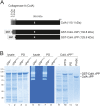Cloning, Purification and Characterization of the Collagenase ColA Expressed by Bacillus cereus ATCC 14579
- PMID: 27588686
- PMCID: PMC5010206
- DOI: 10.1371/journal.pone.0162433
Cloning, Purification and Characterization of the Collagenase ColA Expressed by Bacillus cereus ATCC 14579
Abstract
Bacterial collagenases differ considerably in their structure and functions. The collagenases ColH and ColG from Clostridium histolyticum and ColA expressed by Clostridium perfringens are well-characterized collagenases that cleave triple-helical collagen, which were therefore termed as ´true´ collagenases. ColA from Bacillus cereus (B. cereus) has been added to the collection of true collagenases. However, the molecular characteristics of B. cereus ColA are less understood. In this study, we identified ColA as a secreted true collagenase from B. cereus ATCC 14579, which is transcriptionally controlled by the regulon phospholipase C regulator (PlcR). B. cereus ATCC 14579 ColA was cloned to express recombinant wildtype ColA (ColAwt) and mutated to a proteolytically inactive (ColAE501A) version. Recombinant ColAwt was tested for gelatinolytic and collagenolytic activities and ColAE501A was used for the production of a polyclonal anti-ColA antibody. Comparison of ColAwt activity with homologous proteases in additional strains of B. cereus sensu lato (B. cereus s.l.) and related clostridial collagenases revealed that B. cereus ATCC 14579 ColA is a highly active peptidolytic and collagenolytic protease. These findings could lead to a deeper insight into the function and mechanism of bacterial collagenases which are used in medical and biotechnological applications.
Conflict of interest statement
The authors have declared that no competing interests exist.
Figures





References
MeSH terms
Substances
LinkOut - more resources
Full Text Sources
Other Literature Sources
Molecular Biology Databases

